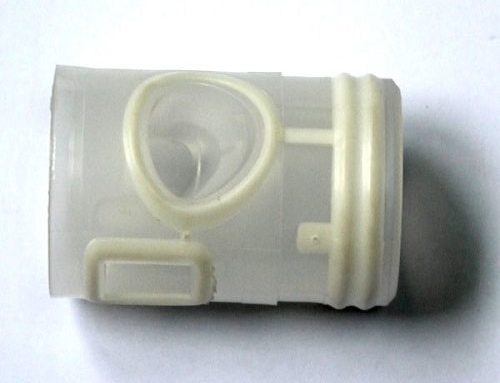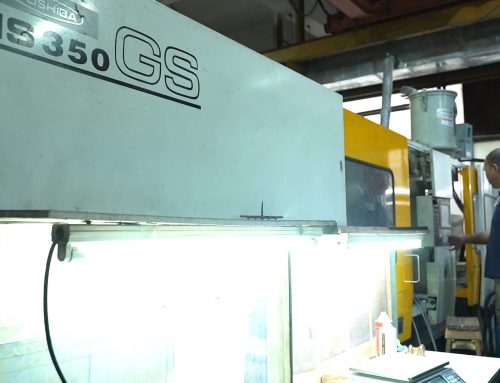Plastic injection molding basic structure and injection molding machine
Basic structure of plastic injection molding is composed of two parts: fixed mold and dynamic mold. Fixed part is mounted on fixing plate of plastic injection molding machine, and movable part is mounted on moving plate of plastic injection molding machine.
During injection molding, fixed mold part and hydraulically driven moving mold part are closed by guide column guiding, and plastic melt enters cavity from nozzle of injection molding machine through mold casting system; after plastic injection molding is cooled, mold is opened, that is, fixed mold and movable mold are separated. In general, plastic part is left on movable mold, and mold ejection mechanism pushes plastic part out of mold.
According to different functions of various components on mold, general plastic injection molding can be composed of following parts:
- Molding plastic parts
Molding plastic parts are parts that make up cavity in specified, moving part. Usually composed of a punch (or core), a die, an insert, etc., when mold is closed, a cavity is formed for filling plastic melt, which determines shape and size of plastic part.
- Gating System
Gating system is passage through which molten plastic flows from injection molding machine nozzle into mold cavity. It consists of a main flow path, a split flow path, a gate, and a cold feed hole.
- Guide mechanism
Guide mechanism is divided into two types: guide mechanism between movable mold and fixed mold, guide mechanism of ejector mechanism. Former is to ensure that movable mold and fixed mold are accurately aligned when mold is closed, so as to ensure accuracy of shape and size of plastic part.
- Release mechanism
A device for removing molding plastic parts from a mold when mold is opened, which is also called an ejection mechanism. There are many structural forms, such as a ejector release mechanism, a push plate release mechanism, and a push tube release mechanism.
- Lateral Partitioning and Core Pulling Mechanisms
When a laterally convex or convex hole or boss is formed on a molding plastic parts, a lateral punch or core is required for molding. Before mold is opened, the lateral punch or the lateral core must be taken out or withdrawn from molding plastic parts, and molding plastic parts can be demoulded smoothly. Mechanism that moves the lateral punch or the lateral core is called a lateral core pulling mechanism.
- Heating and Cooling System
In order to meet mold temperature requirements of production molds process, mold temperature must be controlled, so mold is often provided with a cooling system and a heating element is installed inside or around mold. Cooling system typically has a cooling water channel on mold.
- Exhaust system
In production molds process, in order to discharge air in cavity, it is often necessary to open an exhaust system, usually by purposely opening a number of grooves on parting surface, or using push rod of mold or matching gap between core and template for exhausting. Displacement of small molding plastic parts is not large, so parting surface can be directly used for venting without having to provide a separate venting groove.
- Other parts
Such as parts used to fix, support molding plastic parts or position and limit.
Classification of plastic injection molding
Rapid injection molding are available in a variety of forms and have many classification methods.
According to characteristics of making injection molds process: thermoplastic injection mold, thermosetting plastic injection molding, low foam plastic injection molding and precision injection mold;
According to type of injection molding machine used: injection mold for horizontal injection molding machine, injection mold for vertical injection molding machine and injection mold for angle injection molding machine;
Casting system according to mold: cold runner injection mold, adiabatic runner injection mold, hot runner injection mold and warm runner injection mold;
According to mold installation method: mobile injection mold and fixed injection mold.
According to structural characteristics of injection mold, it can be divided into following categories:
- Single-part molding
When mold is opened, movable mold and fixed mold are separated, thereby taking out molding plastic parts, which are called single-part molds, also called double-plate molds.
Single-part molding is the simplest and most basic form of injection molding. It can be designed as a single-cavity injection mold or as a multi-cavity injection mold. It is the most widely used injection mold.
- Double parting rapid injection molding
Double-part molding has two parting surfaces. First parting surface, after parting, pouring system is released; Second parting surface, after parting, molding plastic parts is released. Compared with single-part type injection mold, double-faced injection mold adds a partially movable intermediate plate in fixed mold part, so it is also called a three-plate injection mold, which is often used for single or multi-cavity injection molds for point gate feeding. When mold is opened, intermediate plate is separated from fixed plate on fixed guide column to take out pouring system between two plates.
Double-part molding has a complicated structure, high manufacturing cost, and difficult processing of parts, and is generally not used for molding large or extra large plastic products.
- Rapid injection molding with lateral splitting and core pulling mechanism
When plastic part has side holes or undercuts, it needs to be formed by a laterally movable core or slider.
- Rapid injection molding with movable molding plastic parts
Due to some special structure of molding plastic parts, injection mold is required to set movable molding parts, such as movable punches, movable concave molds, movable inserts, movable thread cores or rings, which can be molded with molding plastic parts during demolding, remove mold together and separate it from plastic part.
- Automatic unloading thread injection mold
For threaded plastic parts, when automatic demoulding is required, a rotatable thread core or ring can be placed on mold, and thread can be driven by mold opening action or rotating mechanism of injection molding machine, or a special transmission device can be provided. Core or threaded ring rotates to release molding plastic parts.
- No flow injection mold
No-flow injection mold refers to a method of adiabatic or heating by using a flow channel to keep plastic from nozzle of injection molding machine to cavity in a molten state, so that mold is not poured when mold is taken out. The former is called adiabatic flow channel injection mold, and the latter is called hot runner injection mold.
- Right angle injection mold
Right angle injection molds are only available for angle injection molding machines. In contrast to other injection molds, direction of feed of this type of mold is perpendicular to direction of mold opening and closing. When a typical right angle injection mold is opened, molding plastic parts with flow channel aggregate is wrapped on punch and moved to the left together with movable part. After a certain distance, push mechanism starts to work, pushing pusher plate to push plastic part off punch.
Mainstream of right angle injection mold is placed on both sides of moving and fixed mold parting surface, and its cross-sectional area is usually constant (usually round or oblate), which is different from molds used in other injection molding machines. At the end of main flow path, a replaceable flow channel insert can be provided to prevent wear and deformation of injection molding machine nozzle and main flow port end.
- Rapid injection molding of demoulding mechanism on fixed mold
In most injection molds, demolding device is mounted on movable mold side, which is advantageous for ejection device in opening and closing system of injection molding machine. In actual production, because some molding plastic parts are limited by shape, it is better to leave molding plastic parts on fixed mold side. In order to make plastic parts come out of mold, it is necessary to set release mechanism on fixed mold side.




